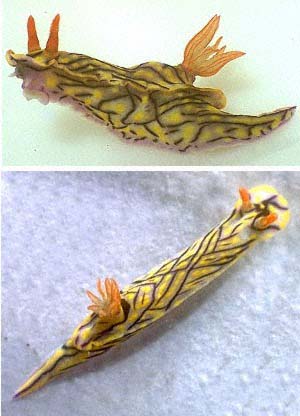
Hypselodoris nigrostriata
(Eliot, 1904)
Order: NUDIBRANCHIA
Suborder: DORIDINA
Family: Chromodorididae
DISTRIBUTION
Indian Ocean.
PHOTO
UPPER: Kunduchi Beach, Dar es Salaam, Tanzania, July 1973. 40mm long. PHOTO: Bill Rudman.
LOWER: Suakin, Sudan, Red Sea, April 1980. PHOTO: Chris Todd.
In colour this species is characterised by the dark blackish lines, usually diagonal, and the yellowish patches between. The background colour of the body has a bluish or purplish tinge, the rhinophores are orange red and the gills, triangular in cross-section are edged with the same colour.
Other species with black lines include Hypselodoris nigrolineata, Hypselodoris maritima, Hypselodoris kanga and Hypselodoris zephyra.
Reference:
• Rudman, W.B. (1977) Chromodorid opisthobranch Mollusca from East Africa and the tropical West Pacific. Zoological Journal of the Linnean Society 61: 351-397.
Rudman, W.B., 1999 (March 21) Hypselodoris nigrostriata (Eliot, 1904). [In] Sea Slug Forum. Australian Museum, Sydney. Available from http://www.seaslugforum.net/find/hypsnigs
Related messages
Hypselodoris nigrostriata or H. zephyra from Lembeh ?
May 19, 2009
From: Sylvain Le Bris
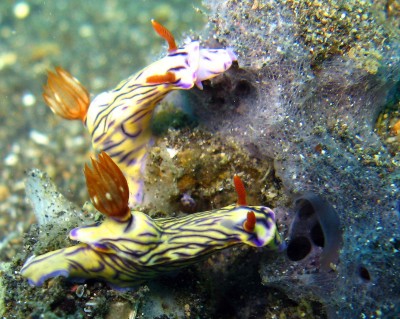
Concerning message #22462:
Dear Bill,
I am not sure that these nudibranchs are Hypselodoris nigrostriata or Hypselodoris zephyra?
Locality: Lembeh, 15 m, North Sulawesi, Indonesia, Pacific Ocean, 08 April 2009. Length: 5 - 6 cm
Regards
Sylvain Le Bris
lebris.sylvain@gmail.com
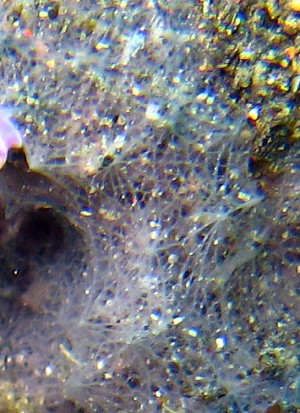
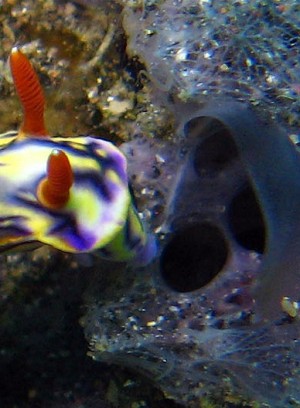
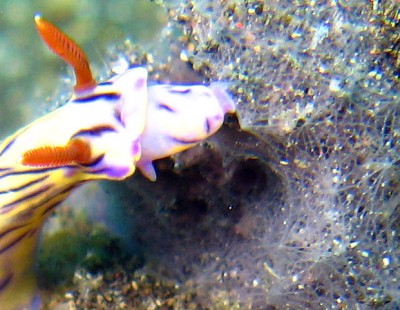
Dear Sylvain,
If those two species are different, then the diagonal purple lines on the mantle would suggest it is H. nigrostriata. In the other species the lines are said to be parallel. Your photo is another nice record of this species feeding. Although we have earlier records of it , and H. zephyra, feeding on this purple species of Dysidea, the more records we accumulate help to confirm its feeding preference.
Best wishes,
Bill Rudman
Feeding Hypselodoris nigrostriata from Bali
October 28, 2008
From: Supapong Areeprasertkul
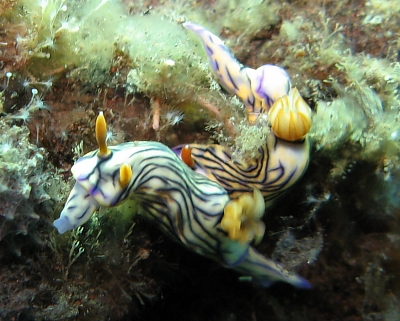
I have just come back from Bali and found that I cannot identify this one. The specimen is very similar to Hypselodoris nigrostriata only there are white tips of the rhinophores. The reference book of Helmut Debelius says the same without detailed identification.
Locality: Beach, 10 metres, Seraya, Bali, Indonecia, Bali, 15 August 2007, Sand bottom. Length: 4 cm. Photographer: Supasate Areeprasertkul.
Supasate Areeprasertkul
zybersup@gmail.com
Supasate, A., 2008 (Oct 28) Feeding Hypselodoris nigrostriata from Bali. [Message in] Sea Slug Forum. Australian Museum, Sydney. Available from http://www.seaslugforum.net/find/20528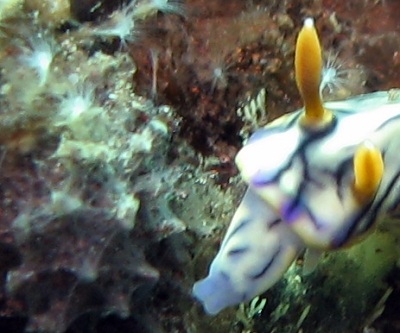
Dear Art,
The main difference between Hypselodoris nigrostriata and H. zephyra is that the former has dark lines which cross diagonally, while in H. zephyra the lines are mainly parallel. Although in the Indian Ocean the rhinophores of H. nigrostriata don't seem to have a white tip, in the Indonesian region we have quite a few examples on the Forum with a white tip. As I have discussed before, the difference between these two species is debatable.
I would call your animal H. nigrostriata. We don't have much information on feeding in that species but both species seem to feed exclusively on a bluish sponge of the genus Dysidea. One of your animals has its oral tube everted and is clearly feeding on the same sponge. Compare it with message #21093 showing H. zephyra feeding. This is a nice additional bit of information on its natural history.
Best wishes,
Bill Rudman
Re: Hypselodoris nigrostriata from United Arab Emirates
September 22, 2008
From: William Messruther

Concerning message #21888:
Sorry I meant to send the attached picture showing the colony of nudies. By the way, the blue is the colour of the wreck hull 'Inchcape 2'.
Locality: Khor Fa Khan , 18 meters, United Arab Emirates, Indian Ocean, 13th September 2008, Inchcape 2 Wreck. Length: 1 cm. Photographer: William R Messruther.
Will
willnita@eim.ae
Messruther, W.R., 2008 (Sep 22) Re: Hypselodoris nigrostriata from United Arab Emirates. [Message in] Sea Slug Forum. Australian Museum, Sydney. Available from http://www.seaslugforum.net/find/21897
Dear Will,
Thanks for clearing the blue colour up - the hull is a good colour match for the sponge they usually eat. In this photo I can see the other nudibranchs and they certainly look as though they are all feeding. While I am happy to accept the blue in the top half of the photo is the hull, I am pretty sure the bluish objects I have circled are small parts of a sponge colony. Unfortunately I can't poke around in the photo to check - and even if I could, it is often very difficult to find or identify these sponges as they can be covered or tangled up in other animal and plant growths.
Best wishes,
Bill Rudman
Re: Hypselodoris nigrostriata from Gulf of Oman
September 17, 2008
From: William Messruther

Concerning message #3505:
Group of at least 3 Hypselodoris nigrostriata
Locality: Khor Fa Khan , 18 meters, United Arab Emirates, Indian Ocean, 13th September 2008, Inchcape 2 Wreck. Length: 1 cm. Photographer: William R Messruther.
William R Messruther
willnita@eim.ae
Messruther, W.R., 2008 (Sep 17) Re: Hypselodoris nigrostriata from Gulf of Oman. [Message in] Sea Slug Forum. Australian Museum, Sydney. Available from http://www.seaslugforum.net/find/21888Dear Will,
Thanks or the photo. I can only see one animal in your photo, were the others you mention nearby? One point of interest are the blue patches in the background. I suspect they are parts of a large colony of the sponge Dysidea sp. which this Hypselodoris feeds on. If there were other H. nigrostriata nearby, I guess they were all attracted to the sponge. Have a look at Yahia Mokhtar Hafez's message [#21264] showing the sponge in more detail. It also shows similar soft corals as well, but I preseume that is just a co-incidence.
Best wishes,
Bill Rudman
Re: Hypselodoris nigrostriata from the United Arab Emirates
December 6, 2007
From: Yahia Mokhtar Hafez
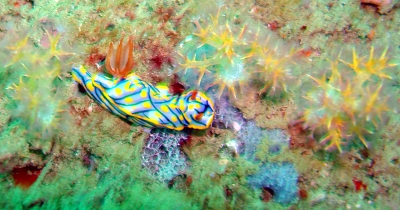
Concerning message #21263:
Thank you dear Bill,
and here are two full photos showing the bluish sponge.
Yahia Mokhtar Hafez
yahia@adma.ae
Mokhtar, Y., 2007 (Dec 6) Re: Hypselodoris nigrostriata from the United Arab Emirates. [Message in] Sea Slug Forum. Australian Museum, Sydney. Available from http://www.seaslugforum.net/find/21264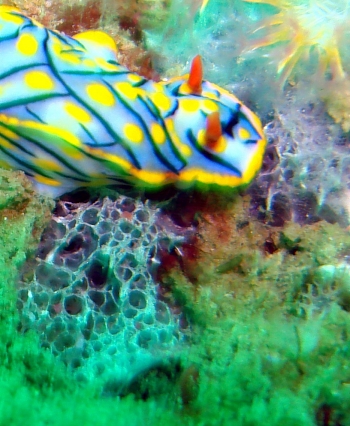
Dear Yahia,
Thanks for the extra photos of the Dysidea. The Hypselodoris has certainly found a little patch of its favourite food.
Best wishes,
Bill Rudman
Hypselodoris nigrostriata from the United Arab Emirates
December 5, 2007
From: Yahia Mokhtar
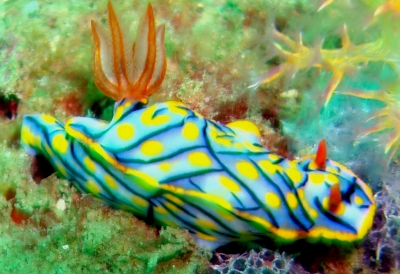
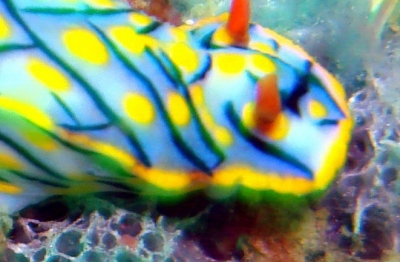
This Nudibranch was found on the bow of a wreck yesterday. Could not get better pictures due to the current around the bow.
Locality: Khurr-Fakkan, 15m, Khurr-Fakkan, United Arab Emirates, Indian Ocean, 03 December 2007, Wreck (Inshcape 2). Length: 15 mm. Photographer: Yahia Mokhtar.
Yahia Mokhtar
yahia@adma.ae
Mokhtar, Y., 2007 (Dec 5) Hypselodoris nigrostriata from the United Arab Emirates. [Message in] Sea Slug Forum. Australian Museum, Sydney. Available from http://www.seaslugforum.net/find/21263
Dear Yahia,
This is Hypselodoris nigrostriata. Of particular interest to me is the bluish sponge with the whitish network of fibres in the bottom right of your photos. This is the remains of a sponge colony [Dysidea sp] which this species is known to eat, so it is a useful confirmation of this nusibranch's food choice.
Best wishes,
Bill Rudman
Hypselodoris nigrostriata from Mozambique.
November 22, 2007
From: David Abecasis
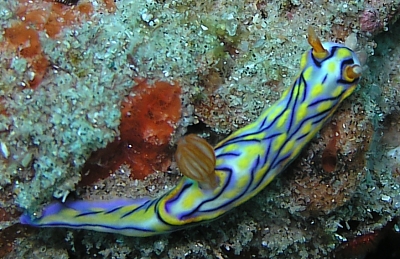

Hi Bill,
I would like your help to identify this nudi. In the beginning I thought it could be Hypselodoris kanga but after reading some more I am not so sure.
Locality: Ponta do Ouro, 16 meters, Moçambique, Indian Ocean, 1 November 2007, rocky. Length: 30 mm. Photographer: David Abecasis
Thanks,
David Abecasis
.
davidbecas@netcabo.pt
Abecasis, D., 2007 (Nov 22) Hypselodoris nigrostriata from Mozambique.. [Message in] Sea Slug Forum. Australian Museum, Sydney. Available from http://www.seaslugforum.net/find/21142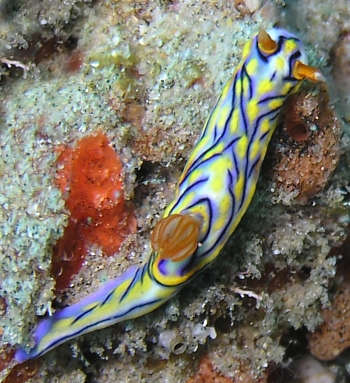
Dear David,
The first time I found this species, I found a single animal with a single specimen of Hypselodoris kanga. By some amazing chance their larvae had found the same colony of sponge growing on a small concrete pipe in the middle of a sandy beach. The pipe was an outlet pipe from the University of Dar es Salaam's marine station in Tanzania, where I was working at the time. It is Hypselodoris nigrostriata and as one animal was an unnamed species and the other hadn't been seen since its original description almost 70 years before, I too wasn't sure if I had two species or two variations of one species.
Both have the same basic markings and both have gills which are triangular in cross-section but in H. nigrostriata the dark blue lines are long and often diagonal, the yellow patches are large and irregular in size and shape, and the gills are lined with red. In H. kanga, the dark blue marks are usually spots or very rarely, short lines, the yellow spots are small and regular in shape and the gills are lined with red and blue, and there are usually yellow spots along the outer face of each gill. Your animal is what I would call a 'typical' H. nigrostriata. I often comment on the difficulty I have at times separating this species from H. zephyra, a species which is even more similar in colour than H. kanga. In H. zephyra the dark blue lines usually run parallel to each other rather than crossing diagonally, and the gills appear to be simple in shape rather than triangular in cross-section. Unfortunately often in photos the gills are slightly unfocussed and its not possible to determine whether they are simple or triangular so H. zephyra and H. nigrostriata often cause me trouble in photo identifications.
In both these photos and those of Hypselodoris regina [message #21141 ] your animals are crawling in an area with many colonies of an orange sponge which I doubt is their food. Supporting that idea is the fact that in all the photos the slugs seem to be avoiding the orange-red colonies.
Best wishes,
Bill Rudman
Hypselodoris nigrostriata from Indonesia
September 27, 2007
From: Francois Zylberman

Dear Bill,
I captured this image of nudibranchs in Lembeh Strait and I'm unable to identify it exactly. Could you please identify it for me?
Locality: Lambeh strait, 15 m, Indonesia, North Sulawesi, Indo Pacific, 30 april 2006, muck dive. Length: 50-70 mm. Photographer: Francois Zylberman.
Thanks
Francois
francois@geodia.com
Zylberman, F., 2007 (Sep 27) Hypselodoris nigrostriata from Indonesia. [Message in] Sea Slug Forum. Australian Museum, Sydney. Available from http://www.seaslugforum.net/find/20766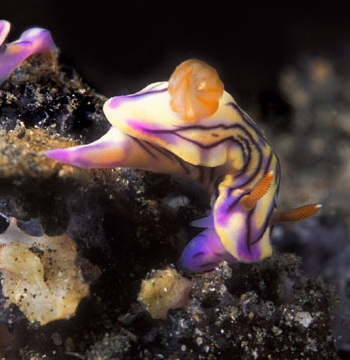
Dear Francois,
I am pretty sure this is Hypselodoris nigrostriata, but I find it pretty difficult to distinguish it from H. zephyra. As you will see from comments I have made in messages concerning both species I have some doubts about whether we are dealing with one or two species here.
Of more interest is that these two animals are feeding on the dark blue sponge. The oral tube of the animal on the right of your photo is clearly visible. The sponge is almost certainly a species of Dysidea, and probbaly the same species as H. kanga is eating in your message #20778.
Best wishes,
Bill Rudman
Hypselodoris nigrostriata from Mauritius
August 14, 2007
From: Fabrice Bettex
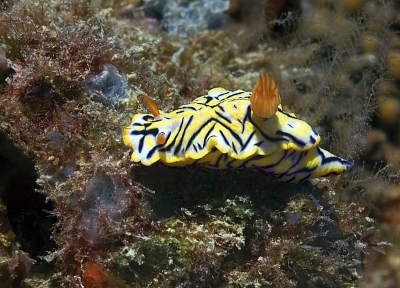
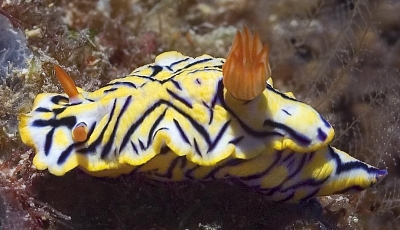
I can't find the name of this sea slug. Could you help me? I thnk it belongs to the Family Chromodorididae?
Picture taken in Mauritius Island - Indian Ocean
Locality: Trou-aux-Biches, 20 m, Mauritius, Indian Ocean, 2006. Length: about 2 cm. Photographer: Fabrice Bettex.
Thanks!
Fabrice
bettex@mysterra.org
Bettex, Fabrice, 2007 (Aug 14) Hypselodoris nigrostriata from Mauritius. [Message in] Sea Slug Forum. Australian Museum, Sydney. Available from http://www.seaslugforum.net/find/20438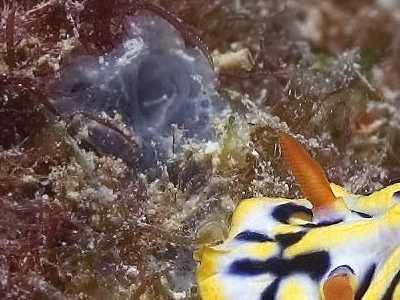
Dear Fabrice,
Yes this is a chromodorid. It is Hypselodoris nigrostriata, and like other animals of this species from the western Indian Ocean it has much more prominent yellow markings than found in specimens from further east. It also appears to be feeding on, or at least interested in, the grey-blue sponge which seems to cover quite a bit of the substrate, and be partly overgrown by branching coralline algae. The sponge appears to be a dysideid sponge which this species has been reported on before [#9500, #6017 ]
Best wishes,
Bill Rudman
Hypselodoris nigrostriata feeding
July 2, 2005
From: Colin Ogden
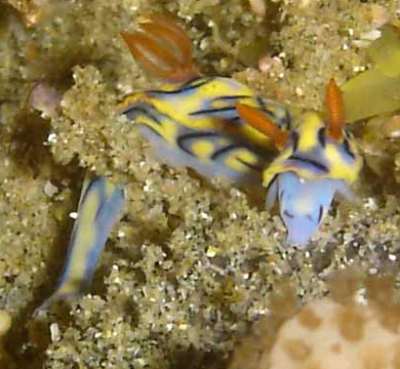
Hi Bill,
A while ago I noticed this tiny nudibranch on a dive here. I took some photo's.
Locality: Sodwana Bay, South Africa. Indian Ocean. Depth: 22 metres. Length: 12mm and 3mm. June 2005. coral reef. Photographer: Colin Ogden
On enlarging them I discovered it was a Hypselodoris nigrostriata actually feeding, but an interesting point was that its extended mouth was just a plain blue colour, with no pattern on it as on other pictures I have seen of it feeding. Also on enlarging the picture I noticed another nudi close by, which I believe is an even smaller creature of the same species, and his pattern is also in the process of developing. Am I correct in my ID, and do they develop their patterns as they grow.
Regards
Colin
scubaco@iafrica.com
Ogden C M, 2005 (Jul 2) Hypselodoris nigrostriata feeding. [Message in] Sea Slug Forum. Australian Museum, Sydney. Available from http://www.seaslugforum.net/find/14181
Dear Colin,
Yes this is H. nigrostriata. As often occurs, the sponge it is obviously feeding on his hidden under a layer of sand and detritus. Most nudibranchs develop their colour pattern as they grow. When they first become small crawling slugs they are a pigmentless and translucent, but grdually they begin to develop the pigmentation characteristic of their species. For this reason it is often impossible to confidently identify juveniles to species level
Best wishes,
Bill Rudman
Hypselodoris nigrostriata from the Solomon Ids
April 21, 2005
From: Bruce Potter
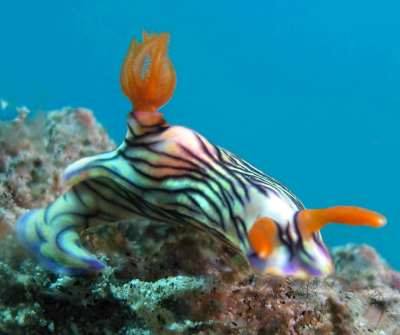
Dear Bill,
The last of my notable finds just before leaving Honiara was this Hypselodoris nigrostriata.I found it at about 8 meters on a coral and rubble site on the outskirts of Honiara, Solomon Islands in January. It was about 30mm long.
Locality: Honiara, Solomon Islands, Pacific Ocean. Depth: 8 meters. Length: 30 mm. 12 January 2005. Coral Rubble Sand. Photographer: Bruce Potter
Regards
Bruce.
bandppotter@bigpond.com.au
Potter, B., 2005 (Apr 21) Hypselodoris nigrostriata from the Solomon Ids. [Message in] Sea Slug Forum. Australian Museum, Sydney. Available from http://www.seaslugforum.net/find/13530Dear Bruce,
This certainly appears to be H. nigrostriata to me. In Hypselodoris zephyra, the black lines are said to be parallel rather than oblique.
Best wishes,
Bill Rudman
Hypselodoris nigrostriata from Thailand
May 20, 2003
From: Danny Van Belle
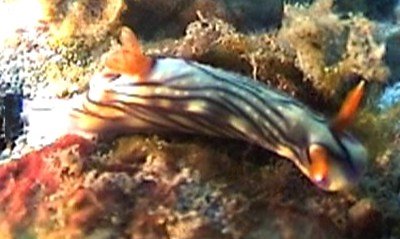
Dear Bill,
Here is another species from Tulamben, Bali, Indonesia. May 2000, Depth around 5m.
This is one more Hypselodoris where I can't put a name on exactly!
Can you help me out?
Cheers,
Danny
dannyvb@hotmail;com
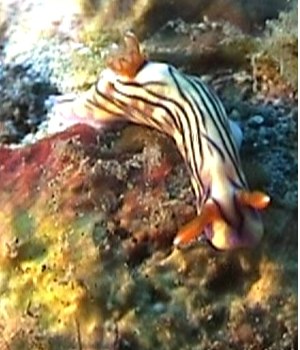
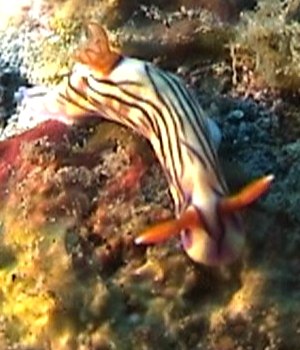
Dear Danny,
I think this is Hypselodoris nigrostriata. See my comment on your earlier message as it is diffiult to distinguish from Hypselodoris zephyra. It looks as though it is eating a brown-yellow sponge in the lower photos.
Best wishes,
Bill Rudman
Hypselodoris nigrostriata - feeding
March 29, 2003
From: Sarah Heaney
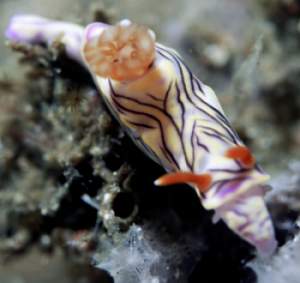
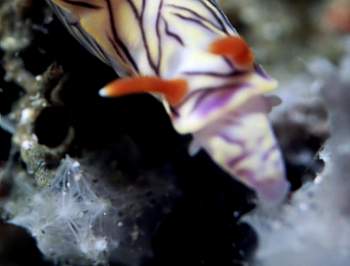
HI
Is this nudibranch a Nembrotha?
It was taken October 2002, Police Pier, Lembeh Strait.
Thanks
Sarah
sarahlheaney@hotmail.com
Heaney, S., 2003 (Mar 29) Hypselodoris nigrostriata - feeding. [Message in] Sea Slug Forum. Australian Museum, Sydney. Available from http://www.seaslugforum.net/find/9500Dear Sarah,
Some species of Hypselodoris do look quite like a species of Nembrotha, but they feed on ascidians, and happily your photo shows the animal feeding on a sponge. The brightly coloured cone sticking out the front of the animal is the oral tube which usually lies inside the 'mouth'. Only when feeding is it pushed out so the feeding apparatus - the jaws and radula - can make contact with the sponge food. This animal is Hypselodoris nigrostriata, and as far as I know this is the first information we have on which sponge it eats.
Best wishes,
Bill Rudman
Hypselodoris nigrostriata from Thailand
March 21, 2003
From: Bill Rudman
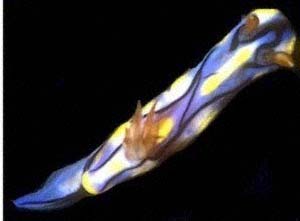
In tidying up two pages on the Forum I am moving this animal, previously identified on the Forum as Hypselodoris zephyra to the Hypselodoris nigrostriata page. See message.
Phi Phi Is, Sth Thailand, 16m. December 1989. PHOTO: D J Brunckhorst.
Bill Rudman
Rudman, W,B., 2003 (Mar 21) Hypselodoris nigrostriata from Thailand. [Message in] Sea Slug Forum. Australian Museum, Sydney. Available from http://www.seaslugforum.net/find/9442Hypselodoris nigrostriata from Bali
February 26, 2003
From: Danny Van Belle
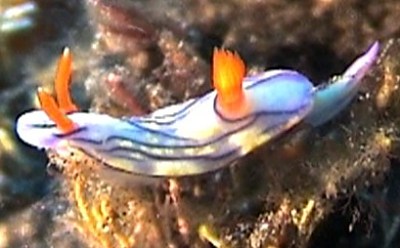
Hi Bill,
This is a Hypselodoris I presume which I can't find back in the list! Any idea?
Location: Tulamben - Bali,
Date: 13 May 2000,
Depth: 5 meters
Danny
dannyvb@hotmail.com


Dear Danny,
This is the eastrn Indian Ocean form of Hypselodoris nigrostriata. It differs from the similarly coloured H. zephyra in that some of the purple lines are diagonal, and the gills are triangular in cross section. In your two lower photos you can see the two orange lines along the outer edge of the gills.
Best wishes,
Bill Rudman
Hypselodoris nigrostriata ? from Bali
October 28, 2002
From: Sabine Noack
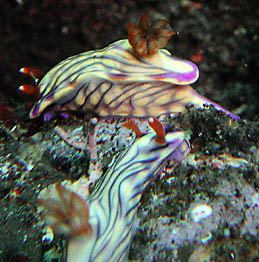
Dear Bill,
Are these 2 beauties color variations of Hypselodoris nigrostriata? They were sitting on a black stone in 4m depth near the shore of Ulami Bay (Tulamben, Bali - 28 Sept. 2002) and remind me very much of the photos Stuart sent you.
Both were very small (< 2cm) and I didn't see the lower one until i looked at the photo :-(
Sabine
dive@snoack.de
Noack, S., 2002 (Oct 28) Hypselodoris nigrostriata ? from Bali. [Message in] Sea Slug Forum. Australian Museum, Sydney. Available from http://www.seaslugforum.net/find/8290Dear Sabine,
Yes I would call these Hypselodoris nigrostriata.
Best wishes,
Bill Rudman
Hypselodoris nigrostriata from Sulawesi
July 10, 2002
From: Mary Jane Adams
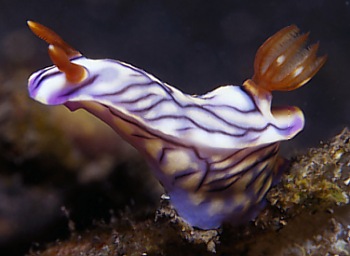
Hi Bill,
I saw several slugs like this in Lembeh Strait, Sulawesi, Indonesia. All had purple striations and red rhinophores with white tips. The gills are red with a central white spot or streak. I did not see yellow spots on any of them in this area. This image is from Teluk Kembahu, a mucky sand slope, April 20, 2002. It was 25mm long. After reading the description of various striated Hypselodoris species on the Forum, I think this best fits H. nigrostriata.
What do you think?
Mary Jane
divepng@yahoo.com
Adams, M J., 2002 (Jul 10) Hypselodoris nigrostriata from Sulawesi. [Message in] Sea Slug Forum. Australian Museum, Sydney. Available from http://www.seaslugforum.net/find/6889Dear Mary Jane,
I would certainly consider this to be Hypselodoris nigrostriata.
Best wishes,
Bill Rudman
Hypselodoris nigrostriata from Bali
July 1, 2002
From: Stuart Hutchison
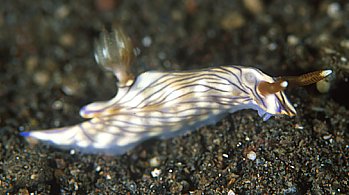
Hi Bill,
I'm not really sure what species this guys is. Depth range from 10-15m, lengths between 40-60mm in Bali, Indonesia on 24 Oct 01.
Regards,
Stuart
stuart@stuarthutchison.com.au
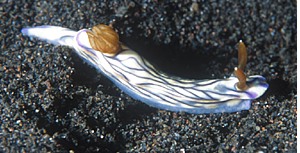
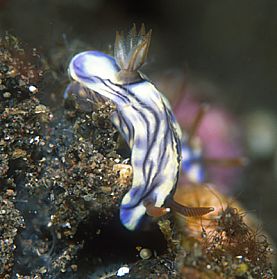
Dear Stuart,
I am pretty sure these are Hypselodoris nigrostriata. Have a look at my comments on other messages on this page. Form them you will see that I have some difficulty separating this species and to see Hypselodoris zephyra.
Best wishes,
Bill Rudman
Hypselodoris nigrostriata? from Lembeh
May 29, 2002
From: John Hoover
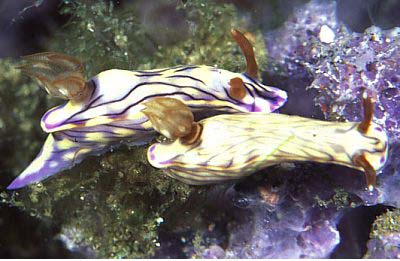
Hi Bill,
These would seem to be Hypselodoris nigrostriata feeding on a blue sponge. Taken under the Police Pier, Bitung, North Sulawesi. (Lembeh Strait). Thought the color variation interesting.
John Hoover
hoover@hml.org
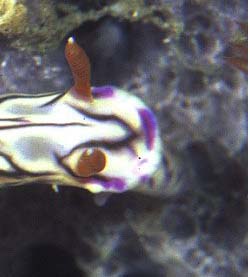
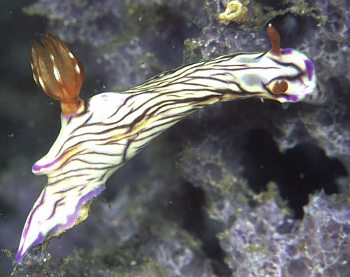
Dear John,
Thanks for these photos. Both the colour variation and the food are very interesting. I have included an enlargement of the head (lower left) showing the multicoloured oral tube extended on to the surface of the sponge - a sure sign of feeding. I am afraid I find it more difficult to differentiate between H. nigrostriata and H. zephyra everytime I see some photos of another specimen.
Cheers,
Bill Rudman
Hypselodoris zephyra? from Japan
January 17, 2002
From: Rie Nakano
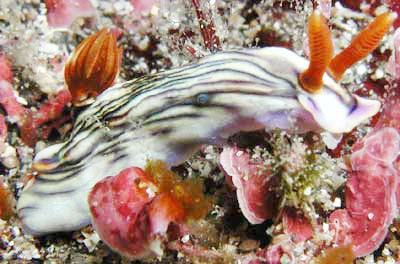
Dear Dr.Rudman,
This animal was found by Mr.Kotaro Tanaka in Hachijo Is, Japan, in December,2001.
I think this one is Hypselodoris zephyra.
Is that correct?
Length: 25mm
Depth: 12m
On the rock on the bottom.
Rie Nakano
rie@divers.ne.jp
Nakano, R., 2002 (Jan 17) Hypselodoris zephyra? from Japan. [Message in] Sea Slug Forum. Australian Museum, Sydney. Available from http://www.seaslugforum.net/find/5900Note added 21 March 2003: The triangular gills make me think this is probably H. nigrostriata. See message.
Dear Rie,
I think this is H. zephyra but as I have discussed before, I am having difficulty separating that species from H. nigrostriata. I thought H. zephrya had simple gills while H. nigrostriata has gills which were triangular in cross-section. Mr Tanaka's photo shows triangular gills which would make this animal H. nigrostriata. Howvere I need to check whether the gills of H. zephyra are indeed 'simple' or are also triangular. I have discussed this problem in an earlier message but am still not clear how to separate these two species from photos. Sorry I can't give you a definite answer at this time
Best wishes,
Bill Rudman
Hypselodoris nigrostriata from South Africa
June 8, 2001
From: Valda Fraser

Dear Bill
Dennis King has given me this image of Hypselodoris nigrostriata to add to our list of species that occur in South African waters. I'd like to confirm the ID.
Thanks.
Locality: Sodwana, north coast KwaZulu-Natal, SOUTH AFRICA, 15m
Date: April 2001
Size: 3 cm
Regards
Valda Fraser
valdafraser@mweb.co.za
Fraser, V., 2001 (Jun 8) Hypselodoris nigrostriata from South Africa. [Message in] Sea Slug Forum. Australian Museum, Sydney. Available from http://www.seaslugforum.net/find/4479Dear Valda,
This is indeed Hypselodoris nigrostriata.
Best wishes,
Bill Rudman
Hypselodoris nigrostriata from Gulf of Oman
January 12, 2001
From: Gordon T. Smith
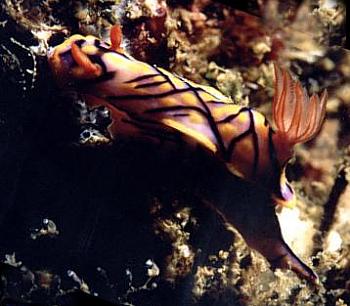
Dear Bill,
Another east coast Hypselodoris from Khorfakkan in United Arab Emirates. Seemed to be fairly common and size from 10-20mm. Depth 15 metres.
Best regards
Gordon
aquashot@emirates.net.ae
Smith, G.T., 2001 (Jan 12) Hypselodoris nigrostriata from Gulf of Oman. [Message in] Sea Slug Forum. Australian Museum, Sydney. Available from http://www.seaslugforum.net/find/3505Dear Gordon,
Another interesting find. There are a group of similarly species in the Indian and Pacific Oceans and until we have a better idea of colour variation in different parts of the world it is difficult to decide whether different colour patterns are restricted to different geographic areas.
Best wishes,
Bill Rudman
Nembrotha? or Hypselodoris nigrostriata?
June 18, 2000
From: Clinton Bauder
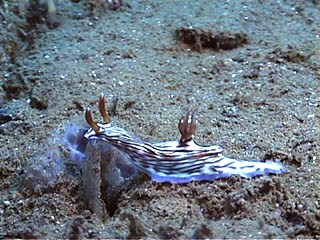
I saw this slug in Milne Bay, Papua New Guinea last summer. At the time I ID'd it as Nembrotha lineolata but Erwin Köhler thinks it is probably Hypselodoris nigrostriata. It isn't the best photo as I grabbed from a still frame of video but I was hoping you could help with a more definitive ID.
Thanks!
Clinton Bauder
gecko1@apple.com
Bauder, C., 2000 (Jun 18) Nembrotha? or Hypselodoris nigrostriata?. [Message in] Sea Slug Forum. Australian Museum, Sydney. Available from http://www.seaslugforum.net/find/2574Dear Clinton,
Erwin is right. It is what I'm calling H. nigrostriata. It is quite similar to the recently described Hypselodoris zephyra but in that species the gills are a uniform orange, and the lines on the mantle are usually parallel not diagonal as in H. nigrostriata.
[Clinton has a website called Metridium Fields which is well worth a look. It includes photos of a number of nudibranchs from Monterey, California.]
Best wishes,
Bill Rudman.
Hypselodoris nigrostriata? from Papua New Guinea
May 5, 2000
From: Wayne Ellis
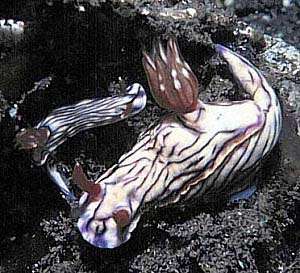
Dear Bill,
In an earlier (February 1999) message of mine, you identified an animal from Milne Bay, Papua New Guinea as Hypselodoris nigrostriata. I am just wondering if it is Hypselodoris zephyra?
Wayne Ellis
glaskin@ozemail.com.au
Ellis, W., 2000 (May 5) Hypselodoris nigrostriata? from Papua New Guinea. [Message in] Sea Slug Forum. Australian Museum, Sydney. Available from http://www.seaslugforum.net/find/2359Dear Wayne,
Good question. The short answer is I don't think so. Hypselodoris zephyra, which was described after your message, is certainly very similar but there is one major point of difference, and that is the shape and colour of the gills. The gills of H. zephyra are described as 'simply pinnate' and uniformly orange, whereas the gills in H. nigrostriata are triangular in cross section. This can be clearly seen in your photo because the two outer corners of each gill are lined with orange (as of course is the inner edge). The rest of the gills are white or faintly translucent orange.
When I looked at your photos again just now, I thought that your animal was H. zephyra, and it is certainly very similar to Vinka Stenhouse's photo of H. zephyra from Vanuatu, but if you look at the gills of her animal they are simple and uniformly orange. The white spots or glands? up the outer edge of the gills in your photo are not present in specimens from East Africa but overall I would say your animals are H. nigrostriata.
One other difference between the two species is that in H. nigrostriata the mantle glands are small and are found all around the mantle edge except for a small region midway down each side. In H. zephyra there are a few large posterior glands and a few small anterolateral glands - none laterally. I can't be 100% sure but it seems to me that in your photo, the way the mantle sits would suggest small glands along the left edge of the mantle, typical of H. nigrostriata - though that may just be wishful thinking on my part.
It would certainly be interesting if both species co-existed along the boundary of the Indian and Pacific Oceans. Any views welcome.
Bill Rudman.
Rudman, W.B., 2000 (May 5). Comment on Hypselodoris nigrostriata? from Papua New Guinea by Wayne Ellis. [Message in] Sea Slug Forum. Australian Museum, Sydney. Available from http://www.seaslugforum.net/find/2359Hypselodoris nigrostriata from Indonesia
March 5, 1999
From: Michael Miller
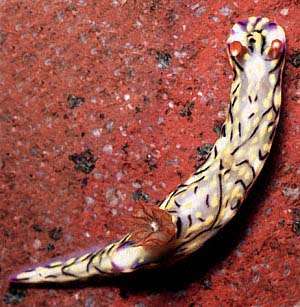
Dear Bill
Continuing the Hypselodoris thread , you will find attached two (2) images
believed to be Hypselodoris kanga and H. nigrostriata. Both images recorded at Tulamben, Bali, Indonesia in Oct. of last year.
Cheers,
Mike.
mdmiller@cts.com
Miller, M.D., 1999 (Mar 5) Hypselodoris nigrostriata from Indonesia. [Message in] Sea Slug Forum. Australian Museum, Sydney. Available from http://www.seaslugforum.net/find/641Dear Mike,
I've put the Hypselodoris kanga photo on the appropriate page. They fill a gap in the known distribution.
Thanks,
Bill Rudman.
Hypselodoris nigrostriata from New Guinea
February 8, 1999
From: Wayne Ellis

Hi Bill,
Attached is a pic which you identified years ago as Nembrotha sp. 30-50mm long, 9m May 1985. Cathies Corner, Milne Bay, New Guinea.
Any further development beyond sp?
Wayne
glaskin@ozemail.com.au
Ellis, W., 1999 (Feb 8) Hypselodoris nigrostriata from New Guinea. [Message in] Sea Slug Forum. Australian Museum, Sydney. Available from http://www.seaslugforum.net/find/545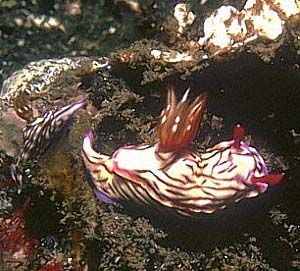
Dear Wayne,
I looked through my files and found another photo of yours which seem to be of the same animals. If I said Nembrotha I must have been having a bad day, as your animal is Hypselodoris nigrostriata. It is one of a group of species of Hypselodoris in which the body has indeed taken on the look of a nembrothid, with a narrowing of the mantle skirt and a heightening of the body. With further study we may decide that the Indian Ocean and Pacific colour forms are consistently different enough to consider separate species but more material from the Indonesian Archipelago and up to Thailand will need to be studied.
Bill Rudman.
